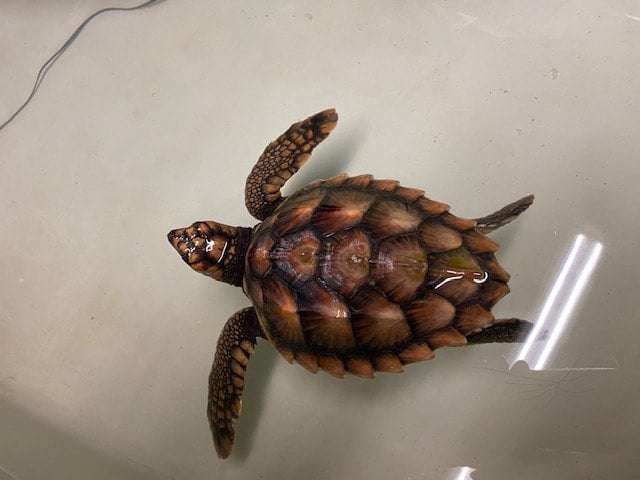Listen Comment on this story Comment Gift Article Share
A family strolling on a beach in Ireland earlier this month spotted a seafarer that had washed up on the rocks. Her body was battered. She was dehydrated, suffering from hypothermia and in danger of having her eyes pecked out by shorebirds. Wp Get the full experience. Choose your plan ArrowRight Death was close. The family worked quickly to try to save the young loggerhead turtle, which had already defied nearly impossible odds. Less than a year old, the female loggerhead survived a months-long journey across the Atlantic Ocean, teeming with dangers including predators and plastic. Although she was still alive, the turtle was dehydrated, massively underweight and suffering from hypothermia that had left her nearly paralyzed.
As the family members mounted a rescue effort, they dared to name their charge. They called her Cróga, the Irish word for “brave.”
They didn’t know whether she would survive.
Cróga was a long way from home. Loggerhead turtles nest in the southeastern United States, mostly from the Carolinas to Florida, said Caitlin Bovery, rehabilitation manager at the National Aquarium in Baltimore. Because of her age and size, Bovery estimated that Cróga is not yet 1 and said she probably hatched on the beaches of Florida last summer.
After hatching on beaches during the night, loggerheads scramble to the ocean. They then swim to the Gulf Stream’s warm waters, taking up residence in floating sargassum, large expanses of brown seaweed that serve as habitat to small fish, shrimp and crabs. The turtles spend a few months to a few years in the shelter of the sargassum, a kindergarten of sorts, said Kevin Flannery, director of the Dingle Oceanworld Aquarium in Ireland.
When they get older and stronger, they drift over to the Canary Islands off the coast of Africa, he added.
Every year, tropical storms blow hundreds, if not thousands, of the small juveniles off course. Nearly all of them are beaten back to the coastline of the southeastern United States, Flannery said. Rehabilitation facilities treating those turtles find them malnourished, dehydrated, injured by predators or filled with plastic they’ve mistaken for food.
But the storms push a few north and farther into the ocean. And those turtles find an additional danger — cold water. Since they’re reptiles, prolonged exposure to cold water can lower their body temperature, inducing “cold shock” or “cold stunning,” which makes them weak and lethargic. Eventually, they can’t swim and are helpless against the vagaries and vicissitudes of the wind and water current.
Flannery said loggerheads have been floating onto Ireland’s shores for years.
“Very seldom are they alive because, at that stage, they’ve spent a month at sea being pounded … and not able to fend for themselves,” he said.
After finding Cróga in the northwestern part of Ireland, the family called a few groups that rehabilitate whales and dolphins. Eventually, they found Flannery. While a small aquarium in County Mayo watched over Cróga, Flannery drove 12 hours round trip to pick up the turtle and take her to his aquarium in the southwestern part of the country.
There, Cróga’s rehabilitation began. Flannery injected saline into the turtle’s upper flipper to rehydrate her. He raised her body temperature slowly over several days to avoid sending her back into shock. He rubbed Vaseline on her shell where it had been damaged.
And he fed her. At Cróga’s age, loggerheads normally weigh 45 to 90 pounds, he said. She weighed about a pound when she washed ashore. Since then, she has gained about 1.7 pounds, nearly tripling her weight.
“It’s quite voraciously feeding now,” Flannery said.
Cróga will stay with Flannery for at least a couple more months. Once he nurses the turtle back to health, he plans to make sure she doesn’t have any diseases and to fill out the necessary paperwork to have the Irish Naval Service take her to the warmer waters of the Canary Islands, something it’s done in the past.
While the odds of Cróga surviving her journey across an ocean were low, especially as she lingered at death’s door, the turtle’s prospects are far better now that she’s under the care of an expert.
“There’s no reason to suspect that it can’t make a full recovery,” Bovery said.

Mehnard on February 24th, 2023 at 17:28 UTC »
"...have the Irish Naval Service take her to the warmer waters of the Canary Islands..."
I'll bet there's a line for that duty.
QMoonie on February 24th, 2023 at 15:24 UTC »
And IIIIII would drift four thousand miles and IIIIII would drift four thousand more 🎵
Claphappy on February 24th, 2023 at 14:27 UTC »
So he wasn't dying then?